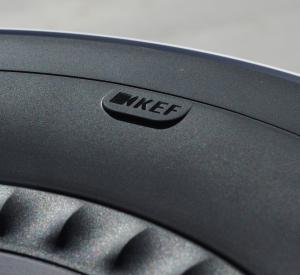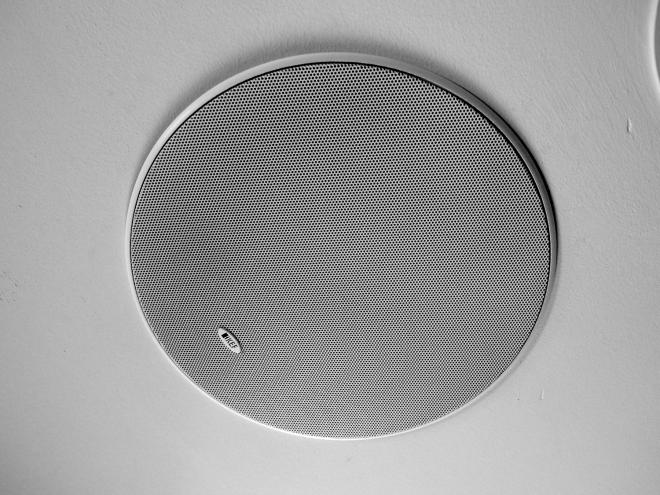Movie & Music Masters: KEF Ci200RR THX In-Ceiling Speakers
Overview -What an exciting year for home cinema enthusiasts. On the video front, we're marching boldly into 4K Ultra HD TV as OLED-panel prices drop. And on the audio side of things, Dolby Atmos has emerged at the forefront of object-based sound mixing theatrically and made its way into our homes (DTS:X debuted as well, but has only one title and I'm still waiting on a firmware upgrade to test it out in my home environment).
Atmos in the home replicates its theatrical origins by adding two to four height channels to more traditional 5.1 or 7.1 systems, creating new terminology along the way. Entry level Atmos systems start at "5.1.2" (five ear level speakers, one sub, and two height speakers), while flagship AV Receivers are capable of processing and amplifying "7.1.4" configurations (seven ear level speakers, one sub, and four height channels). The question, then, for anyone considering Atmos or DTS:X is speaker placement.
Where do we want to and where can we place height speakers?
Dolby, anticipating a variety of customer needs, collaborated with manufacturers to engineer special Atmos speakers that bounce sound off the ceiling to replicate overhead speakers. We've enjoyed testing Pioneer's Andrew Jones speakers, and KEF's R50 Dolby Atmos add-on modules are awesome. We're also trying out the Klipsch Reference Premiere speakers (review forthcoming).
The other Atmos option is in-ceiling speakers.
For my two pennies, Atmos-enabled speakers with up-firing drivers do a damned fine job, but having spent the last two months with localized in-ceiling speakers, I'm leaning more towards in-ceiling. Directional specificity is key to Atmos-immersion and here's where in-ceiling is unbeatable. The tradeoff, of course, is the cost of running wires through walls and, somewhat terrifying, cutting holes in your ceiling.
But it's worth it. So, so worth it.

KEF Ci200RR-THX Specifications
THX ULTRA2 certified, KEF Ci200RR-THX in-ceiling speakers cost $799.99 each. A 1.5" (38mm) Uni-Q driver with a vented aluminum tweeter and "tangerine waveguide" handles high frequencies, while an 8" (200mm) driver with a Z-flex surround wrangles mid/bass tones. These 4 ohm speakers have a 90db sensitivity and a 33Hz - 28kHz frequency response. KEF recommends pairing them with an amplifier between 10 and 190W. As both the HF and LF drivers are centered, they should produce a unified sound that eliminates the need for exact placement to achieve a sweet spot.
KEF Ci200RR-THX speakers weigh 7.94 lbs (3.6 kg) each, are 5.22" (132.6mm) deep, and have a total diameter, including the bezel, of 11.42" (290mm). But remember to only cut a 9.37" (238mm) hole in the ceiling. Thanks to its Ultra-Thin Bezel and magnetic grill, they virtually disappear into white ceilings.
The KEF Ci200RR-THX speakers can be used as in-ceiling surround channels -- when paired with Ci400QL, Ci5160RL-THX, or Ci3160RL-THX in-wall speakers and/or the Ci3160RLb-THX in-wall subwoofer -- but as this review will hopefully demonstrate, they also make terrific Dolby Atmos height channels.

Installation: We're Gonna Need A Bigger Hole
I've been a KEF owner since 2008, when I purchased an entry-level iQ 7.1 system. When making the jump to Atmos, I settled on four Ci160QR in-ceiling speakers as they timber-matched my speakers. I brought in the fantastic ECS AV, Inc, out of Redondo Beach, to wire the whole room up for 7.1.4 and install the Ci160QRs.
KEF reached out two weeks later, wanting to know if I was interested in trying out the Ci200RR-THX speakers. My "YAAAASSSS!" reply was so fast it traveled back in time and arrived before the initial email was ever sent. Or so the legend goes.
When they arrived, I took it upon myself to take down the original speakers, widen the holes, and install the larger Ci200RRs. Aside from the wire running, which I did not do, it was actually a pretty painless process. KEF includes a template with each speaker, which I painters' taped to in position before making cuts. Cut exactly on the template lines; a millimeter too narrow and they won't fit into place.
The Ci200RR-THX in-ceiling speakers are pretty hefty at 7.94 lbs. Since we live in earthquake country and we'll soon have a toddler in the house, I elected to utilize the built-in safety-loop, which requires the additional purchase of wire and hooks to drill into the ceiling joists. KEF says the speakers are not going to fall out of your ceiling, but they put this safety loop into place for situations where the ceiling itself could become compromised. To me, it was worth the extra $10 in supplies and 10 minutes of additional installation.
Safety loops engaged, one simply pops the speaker into the hole, and turns the screw heads until the plastic feet turn outwards and grip the drywall. Super easy, though I was surprised how tired my arms became supporting eight pounds directly over my head for an extended period of time. It might be a good idea to have a friend help (holding tools, at least).
Oh, I also put a little bit of pink insulation above the speakers to keep the sound pointed downwards. Just keep the insulation clear of anything electrical or anything that produces heat.
After installation, I paired the Ci200RR-THX with the beastly Onkyo TX-NR3030 AV Receiver (review HERE), set the speaker locations (front and rear in-ceiling), measured distances, calibrated levels, and set the crossovers. THX specs say 80Hz is the sweet spot, but the Ci200RR-THX, at 8", can handle a little more, so I went for 60Hz and was very pleased with the results.

Dolby Atmos 7.1.4 to 5.1.2
I had been rocking 7.1.4 with the Ci160QRs for two weeks -- they have a 5.25" bass/mid driver -- and I was a very satisfied customer. Then I dropped in (raised up?) the 8" Ci200RR-THX speakers and everything changed.
My ceiling woke the hell up...
Angels cried out in the heavens...
Dolby Atmos objects cheered overhead...
Morpheus dropped by with the red and blue pills, and I popped 'em both...

I honestly had no idea what I was missing until I was no longer missing it. My first demo when rewiring or setting up a new Atmos configuration is a Dolby Atmos Demo Blu-ray. In addition to trailers and short films, it also includes the Enrique Iglesias music video for 'Bailando'. A catchy tune, for sure, but in Atmos, it's remarkable. Instruments and voices -- as individual objects -- pop up in random speakers overhead and in the surrounds. As a whole, it's a fun presentation, but I also like to stand close to each speaker to see what that amplified-channel is doing. The moment I fired up 'Bailando' was revelatory for this system. Much more weight and power (and this was before I started tweaking crossovers and other settings). The upgrade was instantaneous and smile-inducing.
Thirty seconds in, I realized, these are the best in-ceiling speakers I've ever demoed.
You can read a little more about my experience with the KEFs over at the TX-NR3030 Review. I don't want to repeat myself, but the Dolby Atmos technology in a 7.1.4 configuration is, by far, the most accurate theatrical sound reproduction tool ever made available to home cinemas.
And, thanks to Dolby Surround (like Pro Logic IIx, it up-mixes stereo, 5.1, and 7.1 into Atmos), everything sounds more engaging. Does your wife watch 'Real Housewives' on Bravo? Better in Atmos. Those old 5.1 sound mixes from the earliest days of surround sound? Better in Atmos. Concert Blu-rays? Better in Atmos. Even baseball and football games transport the listener into stadiums and ballparks. And, for what it's worth, you haven't watched 'Band of Brothers' until you have streamed it from HBO GO on a Roku 3, turning 5.1 DD+ into Dolby Atmos. Nuts!
It's a game changing technology, made ever so much more impressive thanks to the KEF in-ceiling speakers.
 In fact, everything was perfect until one horrible day.
In fact, everything was perfect until one horrible day.
I had to send the NR3030 back home.
But there was time for one more demo.
A few buddies from HDD corporate HQ wanted to see the new system. I played Atmos trailers. Even rocked out to the Enrique Iglesias video. Then topped it off with the opening sequence from 'Unbroken'. It features a blistering array of bullets and shrapnel and roaring plane engines, sucking the viewer into the middle of a World War II era dogfight. Planes crisscrossed my living room, as the KEFs replicated screaming highs and droning lower frequencies. It was, in short, a maelstrom of sound.
To which the boys replied, "Jesus, your house sounds better than the real theatre." Not true, but close enough.
As the Onkyo sailed for home, another delivery truck dropped off a new toy. The Yamaha AVENTAGE RX-A1050 7-channel AV Receiver is a remarkable piece of engineering. It's 4K capable, includes the new MusicCast whole-home music streaming service, offers world-class room calibration and, of course, decodes Dolby Atmos (DTS:X coming soon via a firmware upgrade). Most interesting is the AVR's rear speaker terminals. Even though it can only amplify a maximum seven channels, it includes connections for nine. Essentially, on the fly, you can toggle between 7.1 and 5.1.2. Add in an external amplifier and it will even support 7.1.2.
The A1050 and the Ci200RR-THX speakers only overlapped for a few days, but I wanted to mention this because the KEFs, again, performed admirably and I have to say I'm definitely still a 7.1.4 guy at heart, but 5.1.2 is surprisingly effective, particularly if you place the surround channels at about 45-degrees behind the listening position. There's a bit of a gap behind you (and behind overhead), but with some tweaking, it's a pretty great option for those who are unable to spring for extra speakers and amplification.

Fun with Mutli-Zone: Ci200RR-THX in Stereo
While we know the KEF 200RRs absolutely kill it in Dolby Atmos, Atmos is content-dependent. Some titles, like 'American Sniper', have little to no height channels, which of course is absolutely fine -- let the filmmakers decide. But if we're going to trot out $799 speakers and give them a Highly Recommended rating, we should probably see how they sound when they're not replicating objects, which tend to be helicopters and bullets and raindrops and music. Piercing, percussive effects, but not always fully dynamic. In other words, we need something a little more consistent.
Both the Onkyo TX-NR3030 and the Yamaha RX-A1050 offer multi-zone capabilities, so after plenty of Atmos testing, I used the Ci200RRs as one or two pairs of in-ceiling stereo speakers.
My first takeaway is that multi-zone is terrific -- sometimes you don't want all seven, nine, or eleven speakers running -- but without smartphone apps to control them, they're incredibly cumbersome to navigate (and tweak). That said, the Ci200RR-THXs impressed once again and were almost impossible to hear in the room directly above thanks to their design and a little insulation
Using a combination of Bluetooth and AirPlay, I spent a few afternoons streaming everything from classic rock to pop, grunge, rap, and orchestral movie scores. The Ci200RR-THXs adapted well to most of these genres, but were particularly articulate with vocal tonalities and screaming highs. The speakers were dynamic and rich and even had a nice sense of stereo panning when sitting between them. Bass replication is also pretty decent, but never quite gets truly low or guttural. If you need thump and thud, add a subwoofer.
My only other MUSIC quibble has to do with the speaker's directionality. In surround mode, they're perfect because they're so precise and the way the sound disperses. KEF is correct, there's no sweet spot, but if you walk too far to the side of the speakers -- say 10-15 feet -- sound levels drop significantly. I suppose this is somewhat positive; play music relatively loud, and yet not blast the whole house from one room. However, if you're looking for a pair of speakers to fill an entire backyard, you might want to consider adding a second pair or finding a speaker that is less precise / has a wider dispersion.
From the quietest volume to reference level, the Ci200RR-THXs never broke, and actually sounded better the more I fed them full range tunes. Okay, now we can say they're Highly Recommended.

KEF Ci200RR-THX Pros
- Crisp highs, mid tones, and vocal reproduction
- Easy to install (not including running wire)
- Makes home Atmos or DTS:X systems sound cinema-quality
- Terrific for multi-zone or MusicCast audio options
KEF Ci200RR-THX Cons
- Price may be a little high for some (they cost as much as some entry-level floorstanders)
- Need a subwoofer for deep, rumbling bass tones

Conclusion
KEF Ci200RR-THX in-ceiling speakers are world class, offering superlative sound replication across a wide range of frequencies. They play loud without ever breaking, but are equally articulate in quieter moments. They would make an excellent addition to any Dolby Atmos home theatre set up and, even though this wasn't part of my testing, should also make great surround or surround-back speakers. They're also terrific options for stereo music listening, reproducing all but the lowest frequencies (a sub is a good idea).
If you own any KEF Q or R series speakers and are looking to add Atmos or extra zones for music, Ci200RR-THX in-ceiling speakers are a no brainer. If you own another brand, these could still work for you, but you might want to seek out a local KEF dealer for a demo before cutting any ceiling holes.












